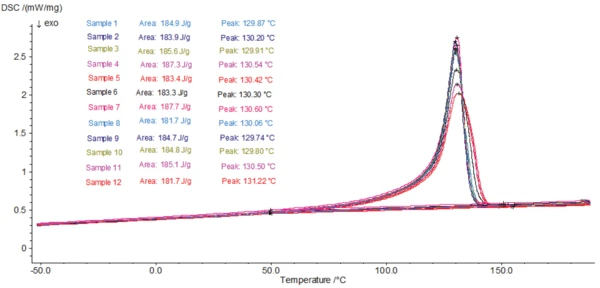Introduction
It is generally assumed that DSC measurements require a flat crucible bottom in order to ensure ideal sample-tocrucible- to-sensor contact. However, due to the manufacturing process, perfectly flat crucible bottoms do not exist: They are always slightly curved, either to the inside or to the outside. For this reason, standard aluminum crucibles are neither perfectly flat nor reproducible in shape, what may certainly influence the reproducibility of DSC measurements.
In contrast, the Concavus® crucibles are intenionally manufactured with a slightly concave bottom (figure 1).
This yields better reproducibility of the shape of the crucible bottom and thus, higher reproducibility of the DSC results.

In the following, measurements were carried out on samples prepared in Concavus® and in standard aluminum crucibles in order to compare the two types.
Test Conditions
24 samples were prepared from the same HDPE tube. For this, round pieces with a diameter of 4 mm and a mass of 12.0 mg each were cut from the tube. Half of these prepared samples were placed in standard aluminum crucibles and the others were placed in Concavus® crucibles.
All 24 samples were measured with the DSC 214 Polyma. For the measurements, the samples were heated twice between -60°C and 190°C at a rate of 10 K/min. Between these two heating runs, they were cooled at 10 K/min. The 2nd heating of each measurement was analyzed by means of AutoEvaluation to guarantee the objectivity of the peak temperature and enthalpy results.
Test Results
The 2nd heatings of all measurements carried out in the standard aluminum crucibles are displayed in figure 2. The equivalent plot with the measurements in Concavus® pans is given in figure 3.


In all of the measurements, one peak was detected around 130°C, resulting from the melting of HDPE. The superiority of the Concavus® crucibles can be clearly seen here: All peaks of the measurements carried out with it are nearly identical in shape, whereas some outliers are present for the measurements with standard aluminum crucibles (samples 6, 11, 12).
The peak temperatures and enthalpies of all these measurements are recapitulated in table 1.
Table 1: Temperatures and enthalpies of the melting peak
Measurement | Concavus® Crucible | Standard Aluminum Crucible | ||
|---|---|---|---|---|
Temperature | Enthalpy | Temperature | Enthalpy | |
| 1 | 129.86 | 178.74 | 129.87 | 184.95 |
| 2 | 129.67 | 179.97 | 130.20 | 183.88 |
| 3 | 130.04 | 180.06 | 129.91 | 185.62 |
| 4 | 129.67 | 180.81 | 130.54 | 187.35 |
| 5 | 129.57 | 180.54 | 130.42 | 183.39 |
| 6 | 129.59 | 182.00 | 130.30 | 183.32 |
| 7 | 129.68 | 181.27 | 130.60 | 187.72 |
| 8 | 129.60 | 181.62 | 130.06 | 181.67 |
| 9 | 129.75 | 180.75 | 129.74 | 184.72 |
| 10 | 129.80 | 179.61 | 129.80 | 184.81 |
| 11 | 129.72 | 177.96 | 130.50 | 185.11 |
| 12 | 129.60 | 178.84 | 131.22 | 181.74 |
| Average | 129.71 ±0.131 | 180.18 ±1.181 | 130.26 ±0.411 | 184.52 ±1.801 |
Relative standard deviation | 0.10 | 0.65 | 0.31 | 0.98 |
1Uncertainty calculated with the standard deviaton
Conclusion
According to the relative standard deviation of peak enthalpy and temperature, the Concavus® pans are 34% better in enthalpy reproducibility and 68% better in peak temperature reproducibility than standard aluminum crucibles. This demonstrates the superiority of the Concavus® pans for achieving highly repeatable DSC measurements.